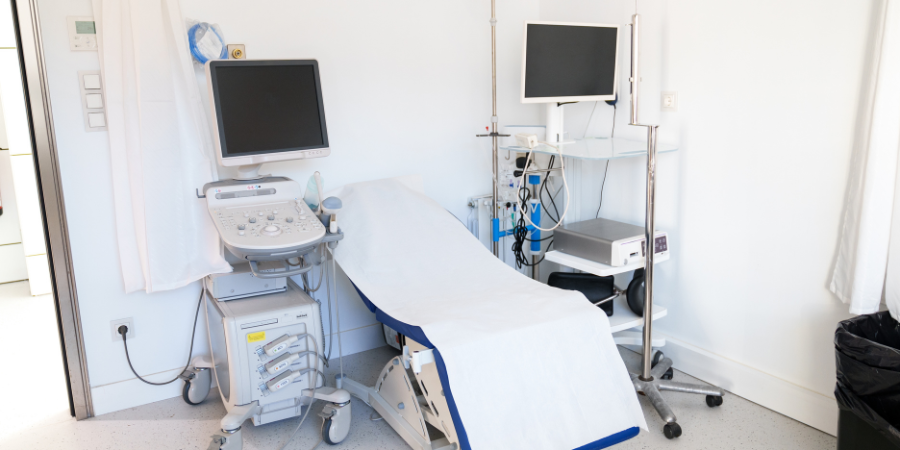
Sonographer Injuries and How To Prevent Them
Sonographers usually fly under the radar in the field of healthcare, yet they’re often the key to making critical diagnoses using ultrasound technology. However, the physical demands of their job can take a toll. Long hours of repetitive motions, difficult postures, and standing or sitting can strain their muscles and joints, thereby increasing the risk of injuries. In this article, we'll explore the common injuries sonographers face and share tips on how to stay healthy and injury-free while continuing to perform this vital work.
Understanding the Physical Demands of Sonography
To truly assess the high risk of work-related musculoskeletal disorders (WRMSDs) in this field, we must first understand the physical impact that performing sonography for long durations has on the human body.
As part of their work, sonographers frequently endure prolonged awkward postures such as twisting and leaning over patients, which can strain the back, neck, and shoulders. Their work also requires repetitive movements, like scanning the same areas repeatedly, which exacerbate muscle fatigue.
Sonographers are often expected to do some heaving lifting (carrying patients or equipment, for example), or they may have to apply excessive pressure while examining patients with higher BMIs. All of these situations can intensify the physical strain on their bodies in the long term.
Multiple work demands contribute significantly to the high rate of WRMSDs among sonographers. The constant strain on their muscles and joints without adequate rest puts them at risk for silent workplace injuries. Sonographers must practice good ergonomics and take preventive measures to maintain their health. Identifying and addressing their physical challenges can help reduce injury risks and ensure a healthier, sustainable career in sonography.
Why Employee Safety Holds Critical Importance in Healthcare
Employee safety is paramount in healthcare, especially for sonographers, whose well-being directly impacts patient care quality and organizational efficiency. Ensuring employee safety minimizes the risk of WRMSDs, which can lead to chronic pain and long-term disability for the sonographer. A safe work environment enhances job satisfaction, reduces absenteeism, and improves staff retention.
For healthcare organizations, prioritizing safety fosters a culture of care and professionalism. Making safety a priority also saves the organization money by reducing expenses related to workers' compensation claims and lost productivity.
By protecting their employees, medical facilities ensure a healthier, more efficient workforce capable of delivering exceptional patient care. All of this can only boost the organization's reputation and performance in the long run.
3 Most Common Injuries of Sonographers
WRMSDs, also known as repetitive strain injuries (RSIs), are among the most common health complaints of sonographers. WRMSDs affect muscles, tendons, and nerves, leading to pain and discomfort. These injuries develop gradually over time due to the need for repetitive actions and the need to bend and twist in awkward ways during scanning. Cumulative strain can significantly impact a sonographer's ability to perform their duties. Three types of workplace injuries are most common among sonographers:
Shoulder Injuries
Sonographers often face the following shoulder injuries due to the physical demands of their work:
- Bursitis. This is an inflammation of the shoulder's fluid-filled sacs, resulting in pain and swelling. It occurs due to repetitive arm movements.
- Tendonitis. This inflammation of the tendons develops from overuse of the arm and can lead to severe discomfort.
- Rotator cuff tears. These are muscle tears caused by prolonged arm abduction and static postures. They can be particularly debilitating, resulting in weakness and limited range of motion. These muscles normally have poor blood flow, and work activities can further compromise that flow and increase the risk of injury by reducing oxygen and nutrient inflow and waste removal. Furthermore, the risk for rotator cuff injuries naturally increases with age.
Hand and Wrist Injuries
Among the injuries sonographers frequently suffer are hand and wrist injuries like:
- Tendonitis. This inflammation of the tendons causes pain and stiffness.
- Tenosynovitis. An inflammation of the tendon sheath, tenosynovitis makes movement painful.
- Trigger finger. This condition results from constantly gripping the transducer, which causes fingers to lock or catch when they’re bent.
- De Quervain syndrome. Continual gripping and pressure on the thumb leads to pain and swelling near the base of the thumb.
Nerve Entrapment Syndromes
When a nerve is compressed or pinched, symptoms arise such as pain, numbness, tingling, or weakness in the area supplied by the nerve. Compression can occur at various points along the nerve's pathway, often due to repetitive movements, prolonged pressure, or anatomical factors. Here are two types that affect sonographers due to overuse of the wrist:
- Carpal tunnel syndrome. Constant wrist flexion/extension during scanning causes compression of the median nerve in the wrist.
- Cubital syndrome. Frequent elbow flexion/extension or pressure on the ulnar nerve leads to numbness, tingling, or pain in the forearm and hand.
The Prevalence of Injuries in Sonographers
Ergonomic concerns in sonography have been studied since the mid-80s. A 1997 study of nearly 1,000 U.S. sonographers found that 84% reported musculoskeletal pain linked to scanning, affecting areas like the neck, shoulders, wrists, hands/fingers, and back.
While modern ultrasound systems now offer adjustable features and specialized exam tables, a 2009 study showed a 90% prevalence of work-related musculoskeletal disorder symptoms among clinical sonographers, indicating a 6% rise from the previous decade despite technological advancements.
How Healthcare Facilities Can Prevent Injuries of Sonographers
Healthcare facilities can significantly reduce injuries among sonographers through proactive measures and by adhering to Occupational Safety and Health Administration (OSHA) guidelines. OSHA sets standards and offers resources to ensure workplace safety, emphasizing ergonomic practices and injury prevention. Here are some ideas for effective measures.
- Healthcare facilities can implement varied job tasks to minimize repetitive motions, reducing strain on sonographers' muscles and joints.
- They can conduct ergonomic assessments to help optimize workstation design for comfort and efficiency.
- They can train their staff in proper lifting and patient handling techniques to reduce the risk of musculoskeletal injuries. They must also teach sonographers the proper posture to use during scans to avoid injury.
- They can offer reasonable working hours and encourage regular breaks to prevent fatigue and overstraining of the sonographers’ muscles and joints.
- They can invest in advanced sonography equipment with ergonomic features that further enhance operator safety and comfort.
Promote a Safer Workplace for Your Sonographers
Preventing WRMSDs is crucial for safeguarding sonographers' health, well-being, and job satisfaction. Implementing ergonomic practices, varying job tasks, and providing proper training not only reduces injury risks but also enhances patient care by enabling sonographers to work comfortably and safely. By prioritizing these prevention strategies, healthcare facilities foster a supportive environment that promotes both employee health and optimal patient outcomes.
As a leading provider of ultrasound services, Premier Ultrasound encourages healthcare providers to prioritize clinical care over operational challenges. This includes resolving staffing issues and managing top-tier imaging professionals. Contact us today to learn more about how our ultrasound services can help you meet the highest industry standards.



